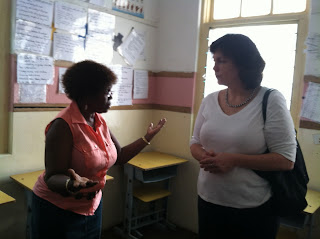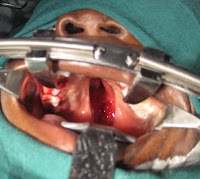After a successful, yet exhausting Saturday, we were all thrilled to sleep in. Many of us slept at least eight hours with perhaps a small interruption from a friendly neighborhood rooster in the early morning. By 9:30am we began trickling into the dining room for breakfast. As more arrived, we reflected on the past weeks events and excitedly discussed our new surroundings to explore on this beautiful Sunday in Kumasi.
Refreshed and well fed, we made our way out to the pool at our temporary accommodation and received our fill of vitamin D and story time. Shortly after, we were off to settle in at the Engineering Guest House at KNUST (Kwame Nkrumah University of Science and Technology). Those of us who had time quickly checked out our new hotel rooms and reported positive findings to the rest of the group. At last, we were ready to enjoy a day off from all of our hard work!
 |
| Post scene photo with the actors |
With a short drive, we found ourselves in a large artisan market with shops selling various goods from jewelry to woodwork. George Odoi had explained to us that Joel Kwadwo Acheampong, one of the artists, was unable to use his legs and arms but was able to create his paintings by holding a paint brush with his mouth. Unfortunately, Joel wasn't at the market today but we saw some of his paintings and made sure we would be able to meet him during our next few days in Kumasi. Many other shops were closed and as we were preparing to move on to another market, we notice a few people filming something. George made his way over and asked a few questions. Next thing we knew, we were starring in a scene in a Ghanaian movie! The movie told the story of a blind man who had been orphaned at a young age. A handful of us had lines in the scene and the director helped us through our 15 minutes of Ghanaian fame.
After a brief water and snack break, it was back to our mystery adventures in Kumasi. With some more luck and bargaining, we found ourselves at a festive music event where performers were sampling new music. There were hundreds of Ghanaians in attendance including a chief from a small village in the North. George had explained to us that people from the audience would be taken from their seats and brought up to the stage. With persuasion from the host of the event, friends would then have to help "bail" them out with donations. The donors would bring money to the stage and place it upon their head, which was seen as a sign of respect. One of our own, Skye MacLeod performed clarinet on stage with one of the Ghanaian musicians and while he performed, we each went to the stage and placed money on Skye's head.
 |
| Skye MacLeod jamming on stage in Kumasi |
Some Ghanaians joined in and helped support Skye. However, stiff competition was yet to come as a small boy of about 7 years came to the stage. The crowd went wild. He sang two great songs (one including the alphabet!) and blew us away with his dance moves. Needless to say, people were running to the stage to praise his performance with donations.
We spent a little while longer listening to performers and being entertained by the host's enthusiastic mannerisms and intonation, although we were uncertain of what he was saying since he was speaking a native language from Northern Ghana. Before leaving, two students mustered up the courage to delve into the events a little bit further. One student was taken from the crowd and earned her donations to be freed and rejoin the group, while another joined the musicians, embracing the music and engaging in traditional African dance.
On our trip home, George explained to us how tribes in Ghana often receive different markings to help identify their tribe. Although this isn't as common today, some still practice it and a number of students had asked about the different types of markings that they had noticed. Interestingly, being in "Ashanti land" (Kumasi), we discovered that Ashanti's have a great disdain for tribal markings because there is a rule that no royalty can have marks on their bodies.
At the end of this adventure packed first day in Kumasi, we enjoyed our typical dinner of rice and chicken or fish. We learned our groups for our next three days in the Komfo Anokye Hospital and Effiduasi Methodist Primary School's "Unit School" and held a short review of the cleft palate course that many of us had taken this past summer. Winding down, we each headed off to our new rooms to rest up for an exciting week two of clinical work in our new location.
-Dana Peterson












































